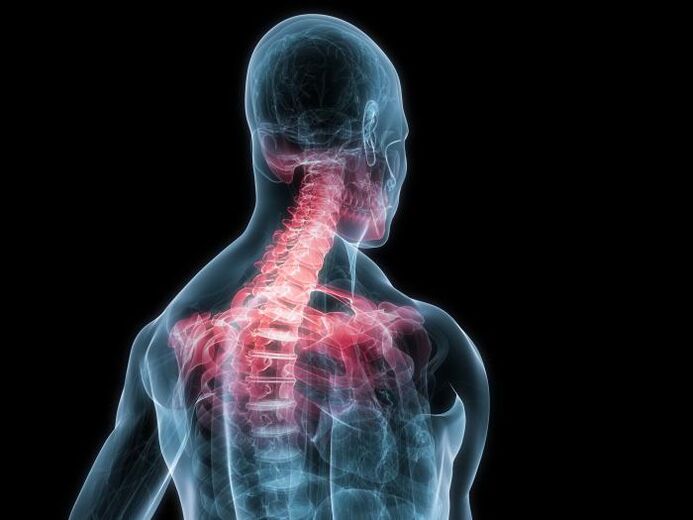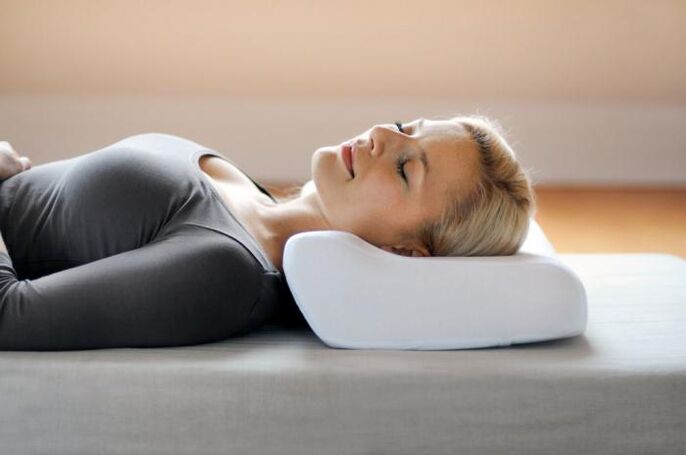Osteochondrosis of the cervical spine is one of the most dangerous types of neurological diseases. What is this disease, how does it manifest itself? What measures help prevent it? How to treat osteochondrosis of the cervical spine? You will find answers to these questions in this article.
Characteristics of the disease
Osteochondrosis is generally a degenerative modification of the intervertebral cartilage discs, which subsequently affects the bone tissue and the nervous system. What happens to this disease? In the cartilaginous disc, which performs a cushioning function in the structure of the spine, dehydration or simply dehydration begins due to metabolic insufficiency. The nucleus begins to press the ring around it and the disc extends beyond the vertebrae. This phenomenon is called bulging. If the membrane ruptures, then an intervertebral hernia occurs, which is even more dangerous.

Osteochondrosis of the cervical spine is a disease that brings a lot of pain and discomfort in a person's life. Unlike the thoracic and lumbar vertebrae, the cervical vertebrae are more mobile, they are the smallest and are constantly under the influence of stress. The disease most often affects these specific segments of the spine. A large number of nerve and blood branches are concentrated in the cervical spine. Here passes an important large vertebral artery that carries nutrients to the brain. The state of contraction of this vessel is dangerous from the development of ischemia of the spinal cord or brain, as well as stroke. If this artery and nerve fibers passing into the cervical spine are affected, then a person loses precise coordination of movements, hearing and vision weaken, there are frequent dizziness and various neurological disorders, which will be discussed below.
Causes
Osteochondrosis of the cervical spine occurs even at a young age. What causes the development of the disease? What causes the disease, even in people under 30? Osteochondrosis of the cervical spine, which requires a lot of time and patience, stems from two main factors:
- hypodynamia or sedentary lifestyle;
- malnutrition.
As a result, there is a disturbance of metabolism (metabolism) throughout the body, especially in bone and cartilage tissues, the level of salt in the blood increases and they, not finding a way out of the bloodstream, find "refuge" intissues of the kidneys, liver and cervical vertebrae. An unbalanced diet leads to a lack of nutrients in the cartilage, as a result of which pathological changes in the intervertebral discs begin. Osteochondrosis is especially susceptible to people at risk.

Let's name the factors, the presence of which increases the likelihood of developing the disease:
- heredity;
- age after 40 years;
- overweight;
- frequent hypothermia (not in vain they say "do not cool your neck! ");
- disorders of the endocrine system, disrupting metabolism;
- spinal injuries;
- systemic lupus erythematosus;
- rheumatism;
- nature of the activity - drivers, office workers, cashiers, athletes, people engaged in hard physical labor.

Symptoms
How does cervical osteochondrosis manifest itself? The symptoms of the disease and the nature of the pain that arises depend on which segments have been damaged. The following conditions may develop in this regard:
- spinal artery syndrome;
- hypertensive syndrome;
- radicular syndrome;
- cervical migraine syndrome.
Let's look at each of them. In vertebral artery syndrome, severe headaches appear in the early stages. One is often dizzy, the gait shakes and the clarity of vision decreases. Sudden movements of the head can lead to loss of consciousness. Radicular syndrome is characterized by a variety of manifestations. They include:
- cervicalgia or severe neck pain;
- crunching when turning the head;
- weakness and tinnitus; tingling and soreness in the hand;
- impaired auditory and visual functions;
- tinnitus;
- cervicobrachialgia or pain that spreads from the neck to the arms;
- feeling of swelling and tingling in the tongue.
Cervical migraine syndrome is characterized mainly by impaired blood circulation in the brain tissues, which causes hypertension and the development of symptoms such as tinnitus and tinnitus, their congestion, dizziness, rapid pulse. The danger of this condition is the possibility of developing a spinal stroke. . Hypertensive syndrome is accompanied by headache aggravated by head movements, nausea and vomiting (especially in the morning), nervousness, sudden changes in pressure, the appearance of dark circles under the eyes, dizziness.

Hypoxia (oxygen starvation) develops in the brain. Cervical osteochondrosis is often manifested by a cardiac arrhythmia in which a uniform heart rhythm is lost. Due to pinching of the lateral vertebral arteries, vegetative-vascular dystonia develops.
Diagnostics
The first step in diagnosing cervical osteochondrosis is to examine the patient. A neurologist visually examines the condition of the spine, back muscles and posture and determines the presence of protruding spinous processes by probing. On palpation, the doctor, by the patient's reaction, will be able to understand which parts are affected by the pain. The hardware diagnostic methods used are:
- radiography;
- computed tomography;
- magnetic resonance imaging;
- dopplerography.
The first method often involves the introduction of a contrast agent into a specific tissue (discography, angiography, etc. ). This is necessary in order to obtain more accurate information about the peculiarities of the course of the disease.

Treatment
Your doctor will tell you how to treat osteochondrosis of the cervical spine and not harm the body. Below are the basic rules and recommendations for dealing with this unpleasant disease, but the beginning of successful treatment is a visit to a neurologist. The treatment of osteochondrosis of the cervical spine is performed using a variety of methods. Among them:
- drug therapy;
- physiotherapy;
- traditional medicine;
- exercises.
Osteochondrosis of the cervical spine is the most dangerous, as important arteries that carry blood to the brain tissue pass through the processes of the vertebrae in this place. Therefore, taking medication and following the doctor's prescriptions should be approached with full responsibility.
Drug therapy
How to treat osteochondrosis of the cervical spine with medication? Drug therapy of the disease includes the following means:
- pain medications;
- anti-inflammatory;
- vitamins;
- chondroprotectors.
Analgesics help relieve pain during exacerbations of cervical osteochondrosis and are used for a short time. Your doctor may prescribe Tramadol, Tolperisone Hydrochloride and Etoricoxib as anesthetics. In case of very severe pain, it is possible to use lidocaine injections.

Non-steroidal anti-inflammatory drugs are designed to reduce inflammation, including Diclofenac, Ibuprofen, Piroxicam. Such funds are also used externally. These are different ointments and gels: Diclofenac and others. Of the vitamins, the most valuable vitamins in terms of maintenance therapy for osteochondrosis are B vitamins, which can reduce tissue sensitivity and weaken the neurological manifestations of the disease.
Chondroprotectors
They are formulated by pharmacologists to restore cartilage tissue. There are two active substances that make up such drugs - glucosamine and chondroitin. Both compounds can be included in one preparation or used separately. Examples of chondroprotectors: glucosamine patches, chondroitin sulfate ointment and others. These funds should be used for a long time, at least 3-6 months, otherwise you may not achieve the desired result.
Blockade
In case of severe pain, injections of drugs directly at the site of the lesion help to alleviate the patient's condition. This injection is called a blockade. A mixture of drugs is usually used as a medicine. One of them has an analgesic effect, the other is designed to relieve inflammation. The blockade can only be done by a highly qualified doctor, in no case do this procedure yourself! This can not only harm the patient's health, but also become life-threatening. This injection is given in two ways:
- drug injection into the ligaments and tissues surrounding the joint;
- injection directly into the intervertebral disc.
Physiotherapy
Physiotherapy procedures are very effective in cervical osteochondrosis. They accelerate recovery, have a beneficial effect on the whole body as a whole. Before we talk about them, we list the contraindications for physiotherapy:
- tumors, oncological diseases;
- blood diseases;
- acute dermatological diseases;
- taking medications that may increase the effect of physiotherapy.
How to treat osteochondrosis of the cervical spine with the help of physiotherapy? In this regard, the use of many methods has a good effect. For example, shock wave therapy is the application of acoustic waves to the lesion. It reduces inflammation, swelling, pain, stimulates collagen synthesis and improves tissue metabolism. Also used laser therapy, magnetic therapy, ultrasound treatment, vibration therapy. The effect on the inflamed area with low-voltage pulse currents or diadynamic therapy reduces the severity of pain. Electrophoresis with the drug "procaine" gives an analgesic effect during exacerbation. Additional physiotherapeutic methods are ultraviolet irradiation of the affected area and spinal traction, or detector therapy.
Physiotherapy exercises
Gymnastics for osteochondrosis of the cervical spine allows you to achieve tangible results. It is important to apply only in the last stage of treatment, as active movements in the neck are strictly prohibited in the first and intermediate stages. Gymnastics is performed with a cotton-gauze collar worn on the cervical region. Resistance exercises are performed with the help of a doctor who tries to tilt the patient's head with his palm, and he in turn makes an effort to overcome the doctor's actions. This strengthens the muscular corset of the neck. The head restraint exercise is also helpful. This is as follows. The patient lying on the sofa raises his head and holds it in this position for 5 seconds. This time increases to 40-60 seconds if the pain and neurological syndrome have already been overcome. Therapeutic gymnastics provides for the performance of each exercise no more than 5 times in one approach.
Gymnastics for osteochondrosis of the cervical spine is designed to:
- improve the blood supply to the affected area;
- to strengthen the muscles of the back and neck;
- reducing the load on the vertebrae;
- normalize joint mobility;
- accelerate glucose metabolism for active nutrition of the intervertebral cartilage discs.

Massage is required for a disease such as cervical osteochondrosis. It refers to the methods of manual therapy and is aimed at relaxing the muscles, improving blood circulation and lymphatic movement at the site of the lesion.
Traditional medicine
Treatment of such a disease as osteochondrosis of the cervical spine, folk remedies are considered an adjunct measure and in no case as a basic therapy. The number of recipes that use different herbs and products is very large. They widely use products such as lemon, garlic, burdock or horseradish leaves (as a compress), dandelion root, St. John's wort, yarrow, lavender and many others. The patient himself is responsible for his health when using traditional medicine.

Nutritional characteristics
How to cure cervical osteochondrosis? This question is asked by many. But how to eat this disease, what foods will be useful? Let's list them:
- dairy products;
- lean meat and fish;
- jelly meat;
- marmalade;
- jelly;
- fresh fruits and vegetables;
- sources of vitamin B - liver, walnuts, brown rice, broccoli, buckwheat, brewer's yeast, green vegetables, kidneys;
- complex carbohydrates - wholemeal bread, cereals, vegetables;
- vegetable fats - olive oil, sunflower, linseed oil.
Do not forget about products that can be harmful in the treatment of osteochondrosis. Do not abuse pastries, baked goods, alcohol, smoked meats and salty foods, spicy foods, animal fats, coffee and strong tea. Remove sugar, potatoes and white bread from the menu.
Prevention
Don't neglect your morning exercises, as well as stretching your neck during the working day. Helps improve blood circulation, thus ensuring the supply of nutrients to cartilage tissue and relaxing muscles. Get more exercise - regular jogging, fitness classes are considered an important measure for the prevention of osteochondrosis. Being overweight often provokes the development of the disease, so try to follow the arrow on the scales. Do not overeat, do not overdo high-calorie foods, fatty and sweet foods. Eliminate all chronic infections in your body. Particular attention should be paid to the correct position of the body during sleep and rest - the neck muscles should not be compressed.

For example, every patient should have an orthopedic pillow for osteochondrosis of the cervical spine, and its use is also useful for disease prevention. Resting on it relaxes the muscles of the neck, and blood vessels do not feel strong pressure.
Cartilage health and diet
Separately, I would like to mention the tendency of girls and women to experience different diets, which are sometimes so cruel and low-calorie that the body begins to use substances from its own tissues as a source of energy. Remember that every diet should be balanced, contain the minimum necessary nutrients, especially protein, and be accompanied by the intake of vitamins and minerals. Otherwise, you risk not only becoming the owner of worn-out cartilage, which is very difficult and expensive to recover in the future, but also a number of unpleasant diseases. And remember that the treatment of osteochondrosis of the cervical spine will be successful only if the patient follows all the recommendations and prescriptions of the attending physician.































